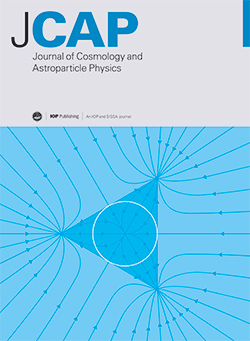Light from darkness: history of a hot dark sector
IF 5.3
2区 物理与天体物理
Q1 ASTRONOMY & ASTROPHYSICS
Journal of Cosmology and Astroparticle Physics
Pub Date : 2025-02-28
DOI:10.1088/1475-7516/2025/02/077
引用次数: 0
Abstract
We study a scenario in which the expansion of the Early Universe is driven by a hot hidden sector (HS) with an initial temperature T' that is significantly higher than that of the visible sector (VS), T' ≫ T. The latter is assumed to be made of Standard Model (SM) particles and our main focus is on the possibility that dark matter (DM) is part of the dominant HS and that its abundance is set by secluded freeze-out. In particular, we study the subsequent evolution and fate of the DM companion particle after freeze-out all the way toward reheating of the VS. To make this scenario more concrete, we work within dark QED, a framework in which the DM is a Dirac fermion and its companion, a massive dark photon; coupling between the SM and HS is through kinetic mixing. We provide a detailed and comprehensive numerical and analytical analysis of the different regimes of reheating of the VS. Extending and complementing the work of Coy et al. on the“domain of thermal dark matter candidates” [1], we use our results to explore the viable parameter space of both the DM matter particle and its companion, here the dark photon. We show that current and future fixed target experiments can probe scenarios along which the expansion was driven by relativistic DM photons, a scenario dubbed relativistic reheating. We also set new bounds on the maximal temperature ratio T'/T and argue for an extension of the domain toward very large DM masses, mdm ∼ 1011 GeV. These are possible assuming that DM annihilation is bounded by unitarity and that reheating of the VS occurs just before big bang nucleosynthesis. We also discuss some possible implications for (and constraints on) baryogenesis, including simple leptogenesis mechanisms, and how they may set additional constraints on the domain of DM candidates.求助全文
约1分钟内获得全文
求助全文
来源期刊

Journal of Cosmology and Astroparticle Physics
地学天文-天文与天体物理
CiteScore
10.20
自引率
23.40%
发文量
632
审稿时长
1 months
期刊介绍:
Journal of Cosmology and Astroparticle Physics (JCAP) encompasses theoretical, observational and experimental areas as well as computation and simulation. The journal covers the latest developments in the theory of all fundamental interactions and their cosmological implications (e.g. M-theory and cosmology, brane cosmology). JCAP''s coverage also includes topics such as formation, dynamics and clustering of galaxies, pre-galactic star formation, x-ray astronomy, radio astronomy, gravitational lensing, active galactic nuclei, intergalactic and interstellar matter.
 求助内容:
求助内容: 应助结果提醒方式:
应助结果提醒方式:


